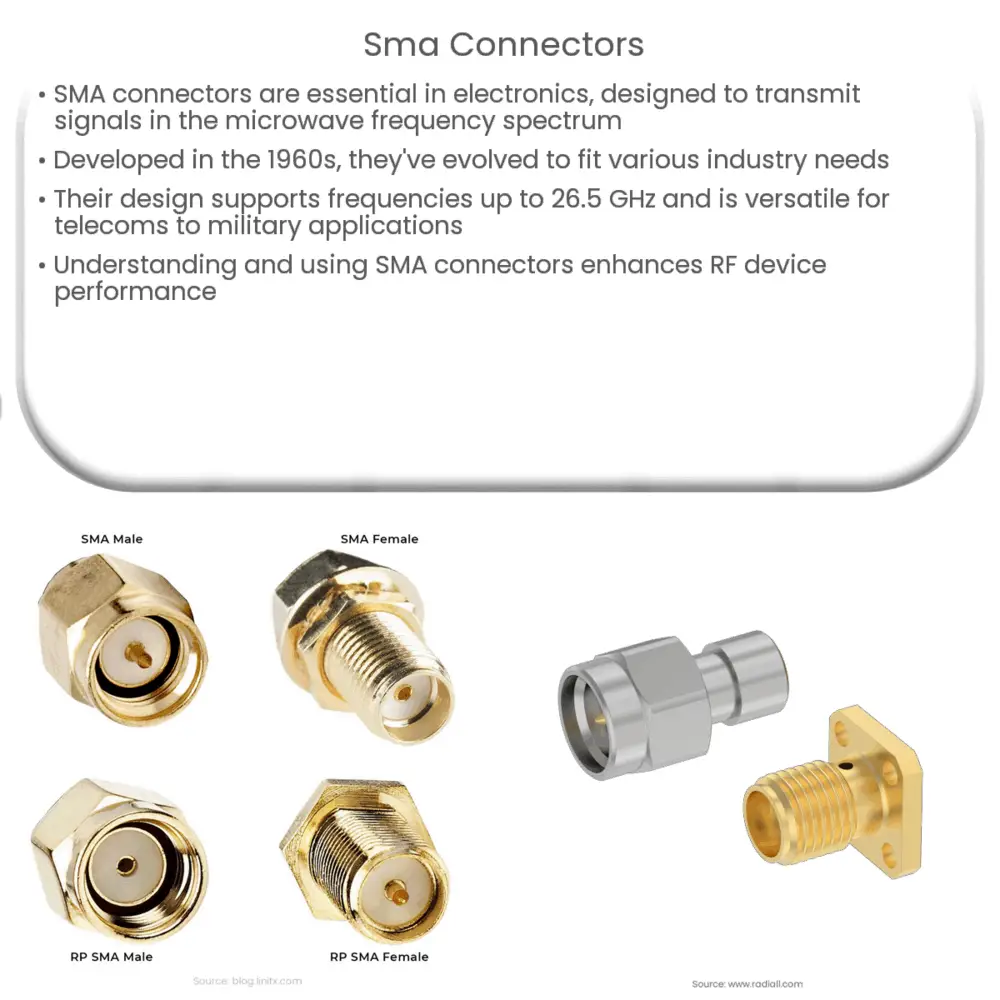Explore the world of SMA connectors: their history, design, types, applications, advantages, and implementation tips for your RF devices.

Introduction to SMA Connectors
The world of electronics is rich with various connectors and interfaces, and one of the most essential amongst these is the SMA Connector. SMA, an acronym for SubMiniature version A, is a type of radio frequency (RF) connector designed to carry signals well into the microwave frequency spectrum. The connector’s design, performance, and wide usage across various domains merit a comprehensive understanding.
A Brief History of SMA Connectors
The SMA connector was developed during the 1960s by Bendix Scintilla Company, now Amphenol Corporation. The connector’s purpose was to provide a robust and reliable means of connecting coaxial cables to RF devices, such as antennas, receivers, and transmitters. With time, the SMA connector has evolved and adapted to meet the ever-increasing demands of various industries.
Design and Characteristics
The design of the SMA connector is elegant and efficient, created to deliver optimum performance. It consists of a threaded outer shell that provides a secure connection, ensuring minimal signal loss. The center pin and insulating dielectric are housed within this shell, forming the ‘male’ or ‘female’ ends of the connector.
The connector’s design enables it to support frequencies up to 18 GHz, but with precision-made variants, it can support frequencies up to 26.5 GHz. Additionally, the SMA connector’s compact size makes it a versatile choice for many applications, including telecommunications and military equipment.
Types of SMA Connectors
- Standard SMA: The most common variant, used for numerous everyday applications.
- Reverse Polarity SMA (RP-SMA): An SMA connector variant with the male and female roles reversed to comply with specific regulatory standards.
- 3.5mm and 2.92mm SMA: These are high-precision SMA connectors designed for higher frequency applications.
The wide range of SMA connectors is a testament to their versatility and adaptability in meeting the needs of different applications. As we delve deeper into the world of SMA connectors, we will further explore their specific uses, advantages, and how to effectively implement them in your projects.
Applications of SMA Connectors
SMA connectors find their use in a plethora of applications. Because of their high frequency carrying capabilities and robust performance, these connectors are extensively used in telecommunications. They serve as critical components in antennas, routers, and other RF devices that require a high-quality signal.
In the military and aerospace industry, SMA connectors are valued for their reliability and durability. They are often found in radar, navigation, and satellite systems. Furthermore, these connectors are also utilized in test and measurement equipment, providing accurate and reliable results.
Advantages of SMA Connectors
SMA connectors offer several advantages that contribute to their widespread use:
- Durability: The robust design of SMA connectors allows them to withstand harsh conditions, making them a reliable choice for various applications.
- High Frequency: With their ability to carry signals up to 26.5 GHz (with precision variants), SMA connectors are an excellent choice for high-frequency applications.
- Low Signal Loss: The threaded interface of the SMA connector ensures a secure connection, minimizing signal loss.
Selecting and Implementing SMA Connectors
Choosing the correct SMA connector requires a clear understanding of your project’s specific requirements. Key considerations include the frequency range, power level, and environmental conditions. Furthermore, when implementing an SMA connector, it is crucial to ensure a secure and tight connection to prevent signal loss. However, one must avoid over-tightening, as it can cause damage to the connector’s components.
Conclusion
In the dynamic realm of electronics, the SMA connector stands as a testament to function and form working together seamlessly. Its history, design, types, applications, and advantages collectively demonstrate the integral role it plays in many industries. Whether you’re delving into a telecommunications project, designing a piece of military equipment, or setting up a home Wi-Fi system, understanding and correctly implementing SMA connectors can significantly enhance the performance of your RF devices.
As we continue to advance technologically, it’s apparent that the humble SMA connector will continue to adapt and evolve, further solidifying its position in the electronic world.

